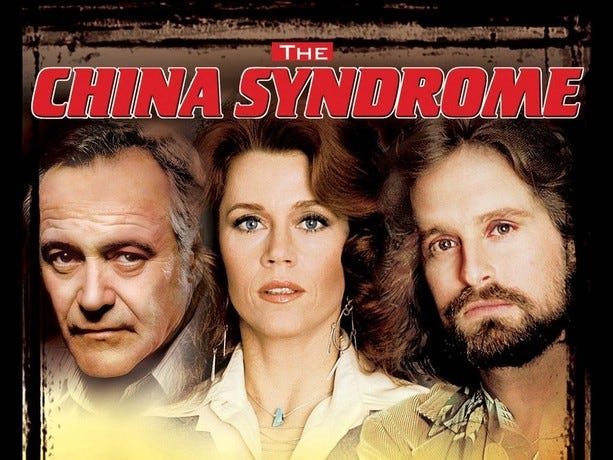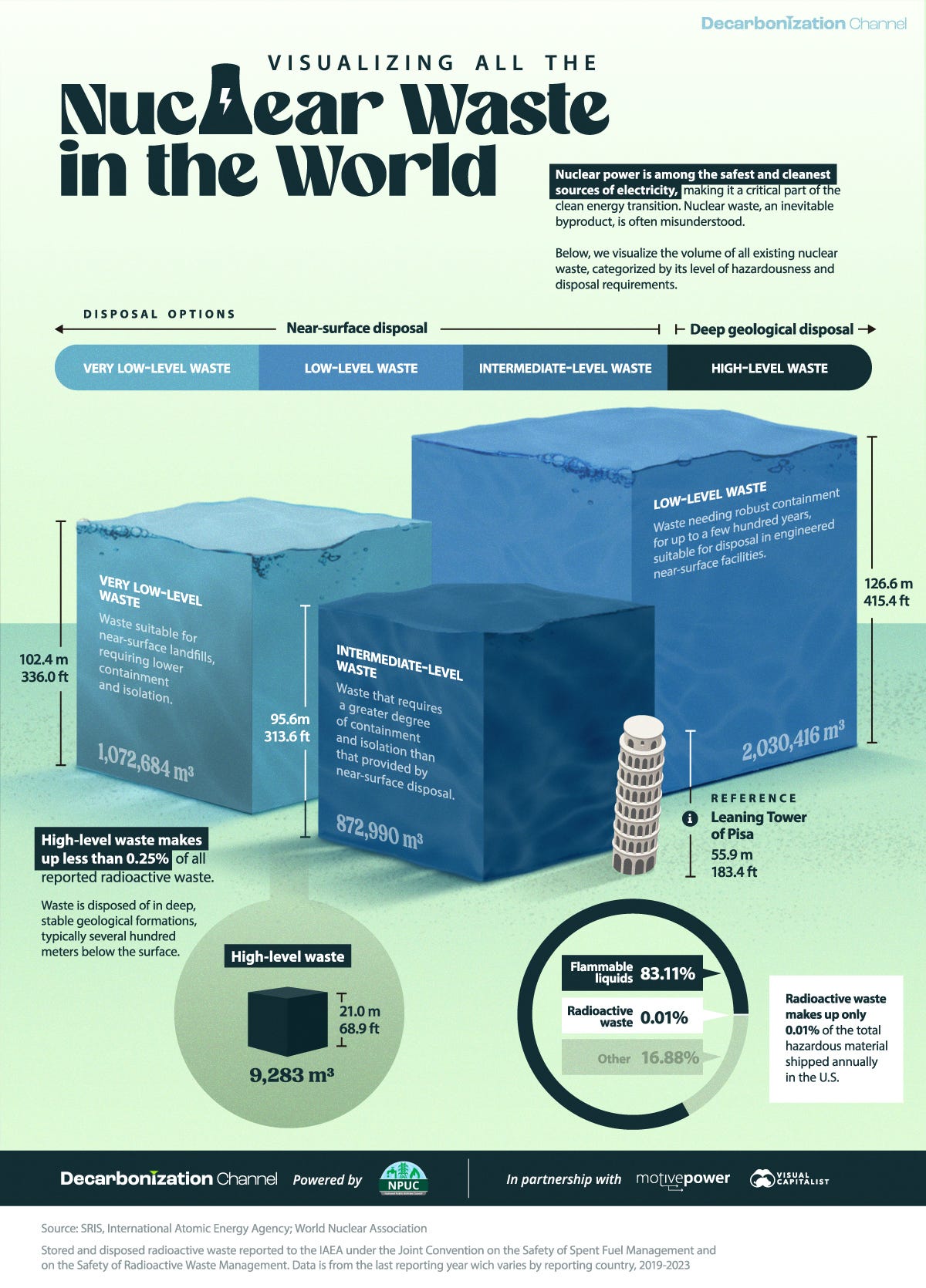Addressing Anti-Nuclear Arguments
Most of the fears are overwrought and/or based on nonsensical issues
Nuclear power has long been a polarizing topic. On one side, proponents argue that it is a clean, reliable, and scalable solution to the world’s growing energy demands and climate crisis. On the other, anti-nuclear activists raise concerns about safety, waste management, cost, and proliferation risks. While these arguments deserve careful consideration, many are either overstated or misunderstand the realities of modern nuclear technology.
There are presently 94 nuclear power plants in the U.S. operating in 28 states and generating ~ 20% of the electrical power in our country. Have you heard of any significant problems? Me neither.
In this blog, I’ll outline the most common anti-nuclear arguments, examine their validity, and provide counterarguments where appropriate. My goal is not to dismiss legitimate concerns but to offer a balanced appraisal of nuclear power’s role in our energy future.
Nuclear Accidents Are Catastrophic
Anti-nuclear activists often point to disasters like Chernobyl (1986) and Fukushima (2011) as evidence that nuclear power is inherently unsafe. These events caused significant environmental damage, forced mass evacuations, and led to long-term health impacts.
Chernobyl was a disaster. The reactor design was awful and they egregiously violated safety protocols and disabled an emergency system while running a poorly planned test. This could not and can not happen in the U.S. for a myriad of reasons.
The 1979 partial meltdown at Three Mile Island (TMI) caused widespread fear but no injuries, deaths, or detectable health effects.1 Studies by the Pennsylvania Department of Health, Nuclear Regulatory Commission (NRC), and Columbia University found:
Average radiation exposure for nearby residents was 1 millirem, comparable to a chest X-ray.2
No increased cancer rates, though psychological stress persisted.3
The 2011 Fukushima Daiichi accident resulted from a 15-meter tsunami overpowering seawalls—a beyond-design-basis event.4
New reactors like the AP1000 and APR1400 situate backup generators elevated and waterproofed to prevent station blackouts.
Post-Fukushima upgrades in the U.S. include portable pumps, hardened vents, and spent fuel pool monitoring.5
Despite reactor meltdowns, no radiation-related deaths occurred, and long-term cancer risks remain statistically negligible.6
The bottom line is you can’t eliminate any risk. But we have learned from every incident, large and small. And we then improve it. If you’re worried about things that can kill us, there’s a long list more worthy of attention.7 Including this.8
Inherent Safety and Physical Resilience
Passive Safety Systems
Advanced reactors like the AP1000 use gravity-driven cooling and convection to shut down safely without operator intervention. For example during a loss of power, water tanks above the reactor automatically drain to cool the core.9
Withstanding Attacks
U.S. reactors are fortified against sabotage:10
Reinforced concrete containment domes withstand commercial aircraft impacts.
Post-9/11 security upgrades include armed response teams and cyberattack safeguards.
Radiation releases from attacks are minimized by multiple barriers: fuel cladding, reactor vessels, and containment structures.
Nuclear Power ≠ Nuclear Weapons
Civilian reactors use low-enriched uranium (3–5% U-235), insufficient for weapons (requires ≥90% enrichment). International safeguards under the IAEA monitor fuel cycles to prevent diversion. Historically, nations like South Africa and Ukraine dismantled weapons programs while operating civilian plants.
In addition issues like Rocky Flats, Hanford, etc. are from nuclear weapons production, testing, etc. Nuclear weapons have as little connection to nuclear power as they do to nuclear medicine (PET scans, etc.).
Nuclear Proliferation Risks
Civilian nuclear programs could lead to weapons development, increasing global security risks. This concern is valid but context-dependent. Civilian nuclear power does involve materials (like enriched uranium) that could theoretically be diverted for weapons purposes. However:
International Safeguards : Organizations like the International Atomic Energy Agency (IAEA) rigorously monitor civilian programs to prevent misuse.11
Technological Advances : New reactor designs minimize proliferation risks by using fuels unsuitable for weaponization.12
While proliferation cannot be entirely ruled out, robust oversight makes it highly unlikely for the reactors we control. A rouge actor, such as North Korea, can do this. However, they developed nuclear weapons independently of the Western world’s nuclear plants.
Nuclear Waste
Current Storage
All U.S. nuclear waste—85,000 metric tons—could fit on a single football field stacked 10 meters high. It is stored in:
Dry casks: Steel-and-concrete containers at plant sites, emitting less radiation than a cross-country flight.
Deep geological repositories: Finland’s Onkalo and proposed U.S. sites like Yucca Mountain (blocked politically).
Reprocessing and Recycling
France and Japan reprocess spent fuel to extract usable uranium/plutonium, reducing waste volume by 95%. The U.S. banned reprocessing in 1977 over proliferation fears but is revisiting it for advanced reactors.
The bottom line is this is a problem we need a permanent solution for. But it’s a very manageable problem for a relatively small amount of content. And we have a solution in Yucca Mountain.
Uranium Mining
Historical Issues
Mid-20th-century mining caused environmental damage and worker exposure, notably in the Navajo Nation. Radon gas and tailings contaminated water supplies. This was really bad.
Today’s Standards
In-situ leaching (ISL) extracts uranium via groundwater wells, minimizing surface disruption.
Strict NRC regulations enforce mine remediation and worker protections.
Recycling spent fuel reduces demand for new mining.
Safety Comparison
Nuclear: <0.01 deaths per TWh, including Chernobyl/Fukushima.
Natural Gas: 0.11 deaths/TWh from explosions, leaks, and air pollution.
Coal: 24.6 deaths/TWh from mining accidents and particulate emissions.
Chemical industries: (e.g., Bhopal disaster) and hydroelectric dams (e.g., Banqiao Dam, 171,000 deaths) have far worse safety records.
Flying: People who fly daily (pilots, flight attendants) are hit with a lot more radiation over the course of their career than nuclear plant workers. This is the job with the largest radiation impact.
To speak bluntly, we face trade-offs here. Can you come up with a 0.00001% chance event where somehow it blows the reactor content into an aerosol spray then radiation poisoning people in a 20 mile radius? Sure.
But we accept the deaths that come from chemical plant explosions and rail car derailments. We accept the deaths that come from the noxious output of coal plants (that we’re finally working to close). We accept the potential of another 9/11 every time a commercial jet takes off.
Nothing is perfect. We balance the trade-offs. In the case of nuclear we balance the safety of nuclear against the known issues of gas generation13 including regular deaths, CO2 emissions, etc.
Other Claims
Wind & Solar is enough - no it isn’t. Not even close.
Nuclear costs too much - no, it’s cheaper than wind.
It needs too much water - look at the Palo Verde nuclear plant outside of Phoenix. It uses purple water14 from the city for cooling.
People are scared of it - yes very true. But that has shifted and now a majority favor nuclear power.15 And when they learn the price difference of nuclear vs. Wind + Solar + Batteries, that support will increase substantially.
Wrapping It Up
Anti-nuclear activists raise important questions about safety, waste, cost, and proliferation. Some concerns—like radioactive waste and proliferation risks—are valid but addressable with current and emerging technologies. Others—such as fears of catastrophic accidents or prohibitive costs—are often exaggerated or based on outdated information.
Nuclear power isn’t perfect, but neither are any other energy sources. What sets nuclear apart is its ability to provide affordable, large-scale, reliable, and carbon-free electricity—a critical asset in combating climate change.
The choice isn’t between perfect and imperfect energy sources — it’s about evaluating the trade-offs and making the best selection out of the choices. And the best choice is nuclear for baseload power.
Wind & Solar mean gas backup.





This is a very helpful post because it presents fact-based, important reasons why decades-old anti-nuclear myths and narratives should be encased in concrete and buried deep underground. Why? Because anyone who's seriously concerned about tackling global warming AND cares about economic and social justice would (should) take a hard look at current evidence (facts, data, etc), which supports nuclear energy as one of the best tools in our toolbox.
With all due respect to the power of 'story,' I would point out that myths and legends are among the oldest narrative forms. Convincing? Yes: to children, especially. As vehicles for learning, moral guidance, etc etc? Sure. But I suggest that stories are about as useful in dealing with the real world and its energy needs as putting garlic around your neck to ward off vampires.
I'd partly blame ... the Cuban Missile Crisis. Many people were terrified of nuclear annihilation in that specific calendar week. Trauma like that shapes you, consciously and unconsciously.
Greenpeace was founded about 8 years later. Anti-nuke, and as per the name, anti-war.
Statistics -- such as you've compiled -- are great, but stories (narratives) consistently beat mere statistics. (According to Mehdi Hasan and George Lakoff's books.)
And I'm excited that nuclear advocates have begun to explain its merits with increasingly compelling stories.